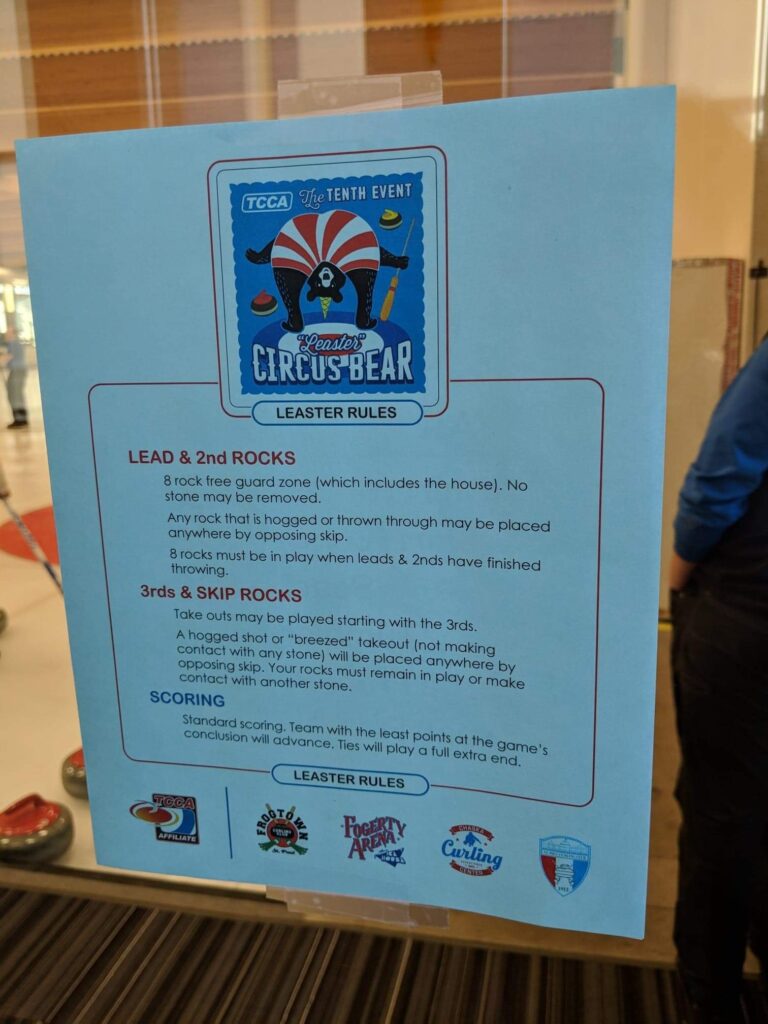What the Heck is a Leaster?
Not sure if you’ve looked ahead, but we’ve got a TON of open ice coming up this month. In the member survey that we conducted last December, it came through loud and clear that members want more open ice. Ice for open practice or focused practice or pick-up games. Maybe some mixed doubles practice? Well, look no further than Tuesdays in March.
March 12: Four of our five sheets are open for practice.
March 17: We have three sheets of open ice for practice and two sheets for Skins games.
March 19: Four, or potentially all five, sheets are open. This would be a great time for pick-up games between Barrel teams.
March 26 is the Leaster.
What the hell is a Leaster? Glad you asked!
The LEASTER is the Perfect Panacea for those Post-Bonspiel Blues. The LEASTER is the exact kind of curling you want to do after you’ve just spent the weekend playing in the hyper-competitive world of The Barrel. The LEASTER is exactly what your legs want when the only thing you can do is throw a guard because, naturally, you played six games over the weekend because, naturally, you made it all the way to the Finals on Sunday. The LEASTER is the perfect game for someone who never, ever wants to draw to the button ever again.
Oh, and wouldn’t it be nice to be able to just PUT your opponent’s stones where you want them to be? Well, The LEASTER allows for that, too.
The goal of The Leaster is to score as few points as possible.
“Well that’s easy,” I hear you say. “I do that on a regular basis.”
“But WAIT!” Billy Mays says. “There’s more.”
Here are the rules of the Leaster:

A few things to note. The first eight rocks (ie all the shots from the Lead and the Second on each team) must stay in play. If you hog a rock or through it through, it’s a violation. If you knock a stone out of play, either out the back or out the sides, it’s a violation. You can promote a guard stone into the house, but if it ekes out the back, it’s a violation.
Takeouts are allowed starting with the vice rocks. But, again, your rock needs to either make contact with another rock or remain in play. If you flash that takeout, it’s a violation.
What happens to a violation? The opposing skip gets to decide where to put it. If the goal is to score as few points as possible, where do you think the opposing skip’s going to put it? And don’t forget they have the next shot, so they can then guard your stone.
Some of us have played in a couple of Leasters, and they’ve got a heck of a lot more strategy than you would think based on the purpose and rules of the game. Guards are important, naturally, as they are in the regular game. Except not center guards. Center guards can be very dangerous, as they’re not difficult to raise into the house. Corner guards are the key. In one game we played, after spending a few ends figuring it out, we started trying to clump as many of the first eight rocks as possible in front of the far edge of the house .
Why are corner guards so great? Because the other team will want to push it into the house. If they hit it on the outside, their stone might spill out, and if that’s one of the first eight shots, your team gets to put their shooter on the button. If they hit the guard on the inside, the guard might spill out, in which case you can put the guard back and move the shooter to the button.
But if your guard goes too much into the corner, it might hit the line and go out of play. We’ve all seen those stones that just keep going farther and farther to the left or right. No biggie in standard curling. Huge no-no in a Leaster.
Oh, and that center guard that you’re trying to raise to the button? You’d better have your weight down, because if it’s one of the first eight stones, and you accidentally push it through the house, then you know what’s going to happen. Oh, and the opposing skip doesn’t have to wait for it to pass the T-line to start sweeping it out. That’s their stone, after all, and they can sweep it the whole way.
So there are the basic rules and a bit of a crash course on what to expect. It really is a wonderfully different approach to the sport that we all love. And that’s why it’s a great thing for the end of a bonspiel. After a weekend of continually trying to do the same thing over and over, you get to wrap your head and your tired legs around some new conundrums.
You can sign up as a team or a pair or an individual. If there are enough teams, maybe we’ll do a little minispiel of two-end games. Maybe we’ll let the teams change their order every end. Who knows? It’s the Leaster. Anything goes!
$25. 5:45. Tuesday, March 26.
